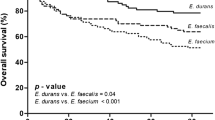Abstract
Pseudomonas putida belongs to the fluorescent group of Pseudomonas species, a group of opportunistic pathogens that primarily cause nosocomial infections. However, few cases of P. putida bacteremia in adult patients have been reported. We report five cases of P. putida bacteremia in adult patients and review 23 previously reported cases. Our five patients consisted of three cases of catheter-related bloodstream infection (CRBSI), one case of indwelling biliary drainage tube-related cholangitis, and one case of cholecystitis. Many of the 23 previously reported cases also included CRBSI. Of the clinical backgrounds, in all 28 reported cases including ours, 24 (85.7%) were immunocompromised. Of the clinical management, in CRBSI, devices were removed in almost all cases (92.9%). Antibiotic susceptibility data of our five cases and another previous case showed that patients with bacteremia had a high susceptibility of P. putida to anti-pseudomonal β-lactams. The prognosis for bacteremia with P. putida was good, as 26 (92.9%) of the total 28 cases were cured.
Similar content being viewed by others
References
Favero MS, Carson LA, Bond WW, Petersen NJ. Pseudomonas aeruginosa: growth in distilled water from hospitals. Science. 1971;173(999):836–8.
Penna VT, Martins SA, Mazzola PG. Identification of bacteria in drinking and purified water during the monitoring of a typical water purification system. BMC Public Health. 2002;2:13.
Roig P, Orti A, Navarro V. Meningitis due to Pseudomonas stutzeri in a patient infected with human immunodeficiency virus. Clin Infect Dis. 1996;22(3):587–8.
Hsueh PR, Teng LJ, Pan HJ, Chen YC, Sun CC, Ho SW, et al. Outbreak of Pseudomonas fluorescens bacteremia among oncology patients. J Clin Microbiol. 1998;36(10):2914–7.
Rastogi S, Sperber SJ. Facial cellulitis and Pseudomonas luteola bacteremia in an otherwise healthy patient. Diagn Microbiol Infect Dis. 1998;32(4):303–5.
Bouallegue O, Mzoughi R, Weill FX, Mahdhaoui N, Ben Salem Y, Sboui H, et al. Outbreak of Pseudomonas putida bacteraemia in a neonatal intensive care unit. J Hosp Infect. 2004;57(1):88–91.
Ladhani S, Bhutta ZA. Neonatal Pseudomonas putida infection presenting as staphylococcal scalded skin syndrome. Eur J Clin Microbiol Infect Dis. 1998;17(9):642–4.
Taylor M, Keane CT, Falkiner FR. Pseudomonas putida in transfused blood. Lancet. 1984;2(8394):107.
Docquier JD, Riccio ML, Mugnaioli C, Luzzaro F, Endimiani A, Toniolo A, et al. IMP-12, a new plasmid-encoded metallo-beta-lactamase from a Pseudomonas putida clinical isolate. Antimicrob Agents Chemother. 2003;47(5):1522–8.
Almuzara M, Radice M, de Garate N, Kossman A, Cuirolo A, Santella G, et al. VIM-2-producing Pseudomonas putida, Buenos Aires. Emerg Infect Dis. 2007;13(4):668–9.
Bogaerts P, Huang TD, Rodriguez-Villalobos H, Bauraing C, Deplano A, Struelens MJ, et al. Nosocomial infections caused by multidrug-resistant Pseudomonas putida isolates producing VIM-2 and VIM-4 metallo-beta-lactamases. J Antimicrob Chemother. 2008;61(3):749–51.
Lee K, Park AJ, Kim MY, Lee HJ, Cho JH, Kang JO, et al. Metallo-beta-lactamase-producing Pseudomonas spp. in Korea: high prevalence of isolates with VIM-2 type and emergence of isolates with IMP-1 type. Yonsei Med J. 2009;50(3):335–9.
Centers for Disease Control (CDC). Reported contamination of heparin sodium with Pseudomonas putida. MMWR Morb Mortal Wkly Rep 1986;35(8):123–4.
Martino R, Martinez C, Pericas R, Salazar R, Sola C, Brunet S, et al. Bacteremia due to glucose non-fermenting gram-negative bacilli in patients with hematological neoplasias and solid tumors. Eur J Clin Microbiol Infect Dis. 1996;15(7):610–5.
Von Graevenitz A, Weinstein J. Pathogenic significance of Pseudomonas fluorescens and Pseudomonas putida. Yale J Biol Med. 1971;44(3):265–73.
Chen CH, Hsiu RH, Liu CE, Young TG. Pseudomonas putida bacteremia due to soft tissue infection contracted in a flooded area of central Taiwan: a case report. J Microbiol Immunol Infect. 2005;38(4):293–5.
Spelman DW, Russo P, Harrington G, Davis BB, Rabinov M, Smith JA, et al. Risk factors for surgical wound infection and bacteraemia following coronary artery bypass surgery. Aust N Z J Surg. 2000;70(1):47–51.
Anaissie E, Fainstein V, Miller P, Kassamali H, Pitlik S, Bodey GP, et al. Pseudomonas putida. Newly recognized pathogen in patients with cancer. Am J Med. 1987;82(6):1191–4.
Yang CH, Young T, Peng MY, Weng MC. Clinical spectrum of Pseudomonas putida infection. J Formos Med Assoc. 1996;95(10):754–61.
von Eiff C, Jansen B, Kohnen W, Becker K. Infections associated with medical devices: pathogenesis, management and prophylaxis. Drugs. 2005;65(2):179–214.
Tolker-Nielsen T, Brinch UC, Ragas PC, Andersen JB, Jacobsen CS, Molin S. Development and dynamics of Pseudomonas sp biofilms. J Bacteriol. 2000;182(22):6482–9.
Koh AY, Priebe GP, Pier GB. Virulence of Pseudomonas aeruginosa in a murine model of gastrointestinal colonization and dissemination in neutropenia. Infect Immun. 2005;73(4):2262–72.
Carlson D, McKeen E, Mitchell M, Torres B, Parad R, Comeau AM, et al. Oropharyngeal flora in healthy infants: observations and implications for cystic fibrosis care. Pediatr Pulmonol. 2009;44(5):497–502.
Mouton JW, den Hollander JG, Horrevorts AM. Emergence of antibiotic resistance amongst Pseudomonas aeruginosa isolates from patients with cystic fibrosis. J Antimicrob Chemother. 1993;31(6):919–26.
Kang CI, Kim SH, Kim HB, Park SW, Choe YJ, Oh MD, et al. Pseudomonas aeruginosa bacteremia: risk factors for mortality and influence of delayed receipt of effective antimicrobial therapy on clinical outcome. Clin Infect Dis. 2003;37(6):745–51.
Osmon S, Ward S, Fraser VJ, Kollef MH. Hospital mortality for patients with bacteremia due to Staphylococcus aureus or Pseudomonas aeruginosa. Chest. 2004;125(2):607–16.
Nelson KE, Weinel C, Paulsen IT, Dodson RJ, Hilbert H, Martins dos Santos VA, et al. Complete genome sequence and comparative analysis of the metabolically versatile Pseudomonas putida KT2440. Environ Microbiol. 2002;4(12):799–808.
Author information
Authors and Affiliations
Corresponding author
About this article
Cite this article
Yoshino, Y., Kitazawa, T., Kamimura, M. et al. Pseudomonas putida bacteremia in adult patients: five case reports and a review of the literature. J Infect Chemother 17, 278–282 (2011). https://doi.org/10.1007/s10156-010-0114-0
Received:
Accepted:
Published:
Issue Date:
DOI: https://doi.org/10.1007/s10156-010-0114-0




